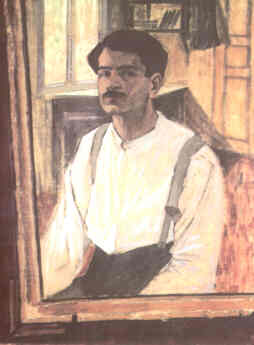 The Georgian artist David Kakabadze was born on 20 August, 1889 in the village Kukhi, Kutaisi Province. In 1901 entered the Kutaisi Gimnasium and was seriously interested in painting. In 1908 he started to learn painting with the painter Paevski.He embarched on his creative career in the first decade of the twentieth century. He evinced a strong interest in the Georigan national traditions. His other concern was the assimilation of the latest art trends then current in Western Europe.Kakabadze's activities encompassed many kinds and genres of visual art: portraiture, still-life and landscape art, miniatures, murals, theatre and cinema settings. His work may be divided into several periods: those of St. Peterburg (1909-18), Tbilisi (1918-19), Paris (1919-27), and again Tbilisi (1927-52).During his Paris years, Kakabadze was in close touch with the latest movements in Western European art. His experiments were much along the same lines as those of Picasso, Dufy and Derain.
The Georgian artist David Kakabadze was born on 20 August, 1889 in the village Kukhi, Kutaisi Province. In 1901 entered the Kutaisi Gimnasium and was seriously interested in painting. In 1908 he started to learn painting with the painter Paevski.He embarched on his creative career in the first decade of the twentieth century. He evinced a strong interest in the Georigan national traditions. His other concern was the assimilation of the latest art trends then current in Western Europe.Kakabadze's activities encompassed many kinds and genres of visual art: portraiture, still-life and landscape art, miniatures, murals, theatre and cinema settings. His work may be divided into several periods: those of St. Peterburg (1909-18), Tbilisi (1918-19), Paris (1919-27), and again Tbilisi (1927-52).During his Paris years, Kakabadze was in close touch with the latest movements in Western European art. His experiments were much along the same lines as those of Picasso, Dufy and Derain.
Photoset: The art of David Kakabadze (Set) by Bakar Matsaberidze











1 comment:
David Kakabadze and Ivane Javakhishvili
The creative work of David Kakabadze clearly tells about unique ethnogenesis of Georgian culture; here is some definitive information: David Kakabadze (1889-1952) was a painter, graphic artist, theatre and movies painter, art researcher (one of his inventions concerned the already well known category of stereoscopic picture and its equipment implementation. David had presented the materials for author’s right but the materials, as he was told, had been lost, though in some years the authorship of some Russian was acknowledged in the sphere of stereoscopic pictures. . . This happened in the 40th of the XX century!)
Studying at the faculty of physics and mathematics of Petersburg University David Kakabadze in parallel mastered in painting and arts history, took active part in the work of ”Georgian Students Scientific Circle” - the group of Georgian students living in Russia. This circle was headed by Ivane Javakhishvili and at the same time he taught David history of Georgian arts. It was from then that Ivane became acquainted with David Kakabadze’s painting and highly appraised his works. . .
At the time of studying in Petersburg David Kakabadze was so short-handed that on October 6, 1912 Ivane Javakhishvili sent a letter to G.Zdanovich (Maiashvili), the head of the Black Stone Producers Society with the request that the Society Board grant David Kakabadze a stipend or render one-time assistance to the young intellectual. In the letter Ivane Javakhishvili characterizes David Kakabadze as an excellent student and, at the same time, a good artist. In the same letter it is also noted that in 1911 Ivane Javakhishvili had given a sample of ancient Georgian painting (a painting preserved in Georgian manuscript by Vakhtang VI and S.-S.Orbeliani) to David Kakabadze and asked him to make a copy. By the statement of Ivane Javakhishvili David Kakabadze had brilliantly executed the mission. Also by the advice of Iv.Javakhishvili the Georgian Society of History and Ethnography had entrusted David Kakabadze to make colored copies of frescos of Quinn Mariam and other historical persons preserved at the Svetitskhovelihich cathedral in Mtskheta; the work was successfully accomplished by the painter.
In the letter to Zdanovich Ivane Javakhishvili points out that since 1912 David Kakabadze under the supervision of Ivane Javakhishvili prepared the research “Development of ornamented fretwork [ornament] in Georgian goldsmith art according to Georgian icons”. The finding and publishing of this work will save such materials of Georgian cultural heritage that is priceless for our church and art and indisputably will enrich the world art treasury.
The report “Development of ornamented fretwork [ornament] in Georgian goldsmith art according to Georgian icons” David Kakabadze presented to the meeting of the Scientific Circle in October 25, 1912. All the samples of Georgian ornaments are compiled in this work and chronologically dated according to the stages of its development (it is, surely, clear what kind of research we are having to deal with - this is irreplaceable basis of knowledge – of Georgian church architecture, iconography, painting and art studies. . .).
In 1915 in Tbilisi was issued “Works of Georgian Students Scientific Circle” of Petersburg University with the preface and editorship of Ivane Javakhishvili where the work “The types of Georgian icons setting” by David Kakabadze was published. In the preface Ivane Javakhishvili notes: “David Kakabadze has studied all known materials and edited pictures, made copies of setting types and investigated chronologically and configurationally, what is that that expresses the development of these types “. . .
Publishing of these materials in high polygraphic level and in several (Georgian, Russian, English, French, German, Hispanic, Italian) languages will have a great importance for the history of Georgian nation, for our cultural heredity, history of Georgian Orthodox apostolic church, for presenting, once more, of Georgia as one of the foundation makers of European Renaissance and for future generations of Georgians, as well. It is time that the civilized world became acquainted with the beginning steps of creative work of David Kakabadze.
Mamuka Matsaberidze
Post a Comment